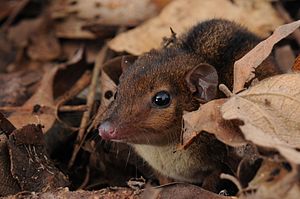Three-lined shrew pouch rat
| Three-lined shrew pouch rat | ||||||||||||
|---|---|---|---|---|---|---|---|---|---|---|---|---|

Three-lined shrew pouch rat ( Monodelphis americana ) |
||||||||||||
| Systematics | ||||||||||||
|
||||||||||||
| Scientific name | ||||||||||||
| Monodelphis americana | ||||||||||||
| ( Statius Müller , 1776) |
The three-lined shrew rat ( Monodelphis americana ) lives in eastern Brazil from the east of the state of Pará in the north to the coastal Santa Catarina in the south.
description
The animals reach a head body length of 9 to 13.7 cm, have a 4 to 6 cm long tail and reach a weight of 23 to 46 g. The tail has a length of about 50% of the length of the head. On the back, the animals are yellow-brown in color, often with a reddish or grayish tinge. Characteristic and eponymous for the species are three black stripes on the back. The middle one runs from the nose, but not clearly visible on the head, to the base of the tail, the other two from the shoulders to the base of the tail. This color pattern is visible in young, adult animals of both sexes and in older females; in older males the stripes disappear and give way to a red-brown or maroon color. The fur on the chin, throat and belly is cream-colored, yellowish or gray with a yellowish-white tinge. There are no dark circles. The tail is hairy only at the base and is black above and light below. The ears are hairless and brown. Females do not have a pouch. The number of teats is 15, one in the middle and seven on each side. The shape and size of the skull are the same in males and females. The karyotype is 2n = 18, FN = 22.
Habitat and way of life
The three-lined shrew pouch rat lives in the Atlantic rainforest and in gallery forests in the cerrado . It is diurnal and largely dwelling on the ground. The nests of the animals made of leaves have, however, been found at heights of up to five meters above the ground. In central Brazilian gallery forests they use a territory of 0.04 hectares and 50 to 150 individuals live on one square kilometer. Like other shrew pouch rats, the three-lined shrew pouch rat feeds on insects and fruits. Their diet also includes the fruits and seeds of the Attalea oleifera palm . The reproduction of animals has so far been little researched. Young animals were only caught from January to May, from the end of the rainy season to the start of the dry season. The animals probably only reproduce once in their life ( semelparity ).
Systematics
The German theologian and zoologist Philipp Ludwig Statius Müller , who described it in 1776 under the name Sorex americana , i.e. assigned it to the shrews , is considered to be the author of the first description of the three-striped shrew rat . It is possible that several species are listed today under the name Monodelphis americana . Whether this is the case needs to be clarified through further research. Under the names Monodelphis rubida and Monodelphis umbristriata , two other species have been described that have a slightly different coloration from Monodelphis americana . In DNA analyzes, however, they are within the range of variation of Monodelphis americana , so that they must be viewed as synonyms of Monodelphis americana .
status
The three-lined shrew pouch rat is considered safe by the IUCN . It is numerous, has a wide range, and is also found in some protected areas.
supporting documents
- ↑ a b c d e Diego Astúa: Family Didelphidae (Opossums). in Don E. Wilson , Russell A. Mittermeier : Handbook of the Mammals of the World - Volume 5. Monotremes and Marsupials. Lynx Editions, 2015, ISBN 978-84-96553-99-6 . Page 149–150.
- ^ Philipp Ludwig Statius Müller: Supplements and register volume on all six parts or classes of the animal kingdom . Gabriel Nicolaus Raspe, Nuremberg 1776.
- ↑ Monodelphis americana in the endangered Red List species the IUCN 2018 Posted by: Astua de Moraes, D., Cáceres, N., Brito, D. & Costa, LP, 2015. Retrieved on July 3 of 2019.
